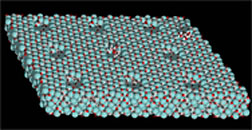- Number 381 |
- February 4, 2013
Nanoscale "Goldilocks" phenomenon could improve biofuel production

A computer graphic showing a fructose
molecule (white, gray and red chain-like
structure) within a zirconium oxide nanobowl
(at center). Other nanobowls in the array
are unoccupied. The red atoms are surface
oxygen and the blue atoms are zirconium.
In a case of the Goldilocks story retold at the molecular level, scientists at DOE's Argonne National Laboratory and Northwestern University have discovered a new path to the development of more stable and efficient catalysts.
The research team sought to create "nanobowls" -- nanosized bowl shapes that allow inorganic catalysts to operate selectively on particular molecules.
Catalysts are vitally important substances that enable the production of everything from petroleum to soap. In 2009, Argonne and Northwestern, along with the University of Wisconsin at Madison and Purdue University, jointly founded the Institute for Atom-Efficient Chemical Transformations (IACT) to research new catalyst designs to improve the efficiency of producing fuels from biomass. IACT is one of the Energy Frontier Research Centers funded by DOE's Office of Science to accelerate research toward meeting our critical energy challenges.
"Nanobowls are intended to mimic the selective enzymes found in nature," said Argonne chemist Jeffrey Elam. "We can tailor the nanobowl size and shape to accept certain molecules and reject others."[Jared Sagoff, 630.252.5549,
jsagoff@anl.gov]
